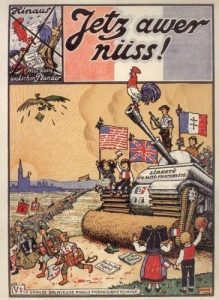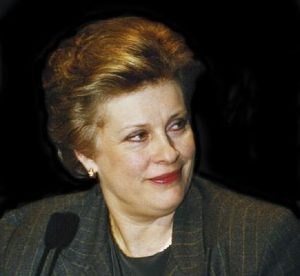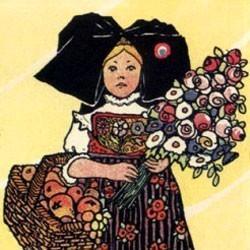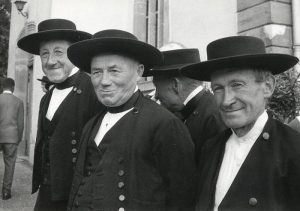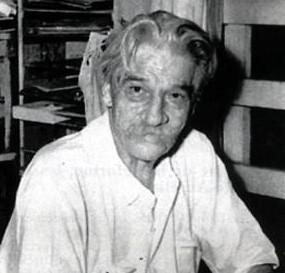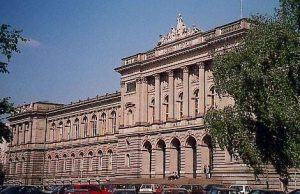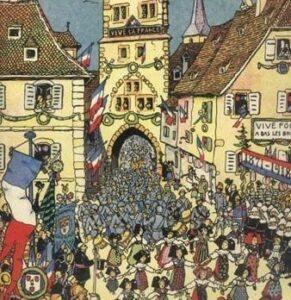Liberation and « cleansing »
« Cleansing », encouraged by the returned evacuees, caused difficult problems, and often became a way of settling accounts, sometimes between Catholics and Protestants, the former accusing the latter of having collaborated. Some, like C. Maurer, were arrested and banished, others condemned to « indignité nationale » (« national unworthiness ») were amnestied between 1953 and 1955, others were disallowed from civil employment. The Malgré Nous (« despite us ») who came back from both fronts were humiliated. The camps were re-opened and more than 6,000 people interned between November 1944 and July 1945.
Fortunately, the action of efficient and clever prefects, most of whom knew Alsace, avoided the errors of 1918. They supported reconstruction and economic revival. Nursery schools were founded to ensure French language teaching.
The political situation
Politically, public opinion was split three ways, with inevitable variations appearing over the years :
The Catholics rallied to the new party called the Mouvement Républicain Populaire (Popular Republican Movement) dominated by the strong personality of P. Pfilmin. He was the mayor of Strasburg, representative from 1945 to 1967, minister several times, and then next to last President of the Council of the 4th Republic, before the return of General de Gaulle in 1958. After 1965, the MRP opened its doors to the Protestants.
The « liberal » Protestants were one of the strongholds of Gaullism, as shown by the percentage of Gaullist votes always superior to those in the other French regions. They were often associated with the « national » Catholics.
The socialist party increased its audience with Protestant figures, such as Catherine Trautmann.
Two thirds of Alsace can be said to have remained right-wing. Though Alsace no longer has a regional party, it is first and foremost for Alsace. Faced with the importance of immigration, Alsace has turned progressively to the extreme right-wing, so that in the first round of the presidential elections in 1995, Le Pen (president of the extreme right wing movement National Front) won 24.5% votes, against 15.5% on a national level.
Religious life
Until the end of this tragic century, religious practice steadily declined. At the Liberation there were not enough pastors. Until 1960 not all positions were taken, and recruiting was mostly done in the lower classes. A feminisation of the pastoral body was seen. In 1963 three-quarters of the worshipping was still in German, but the percentage has decreased. The faculty of theology in Strasbourg was active and published the « Revue d’Histoire et de philosophie religieuse » (Journal of History and Religious Philosophy), profiting from the strong personalities of François Wendel, Roger Mehl and Oscar Cullmann. After 1968 young pastors led very active political reflection groups, thus launching intense debates.
The number of Protestants decreased from 322,000 in 1910 to 251,000 in 1962 and 228,000 in 1991(B. Volger). They still hold high positions in the realms of university and industry, but on the whole their local power waned, as shown by the decrease in the notoriety of the Protestant Societé industrielle de Mulhouse (Industrial Society of Mulhouse).
The liturgy in French seemed abstract and more difficult to some people than in German, with its many hymns. A 1974 decree organised religious teaching in schools for all confessions, two to three hours per week, and advocated interdenominational studies. If scouting decreased, the number of meetings dominated by individual engagement increased, as well as community life, retreats, and support for the third-world.
Ecumenism seemed a primordial need, between Lutherans and Reformed, and between Protestants and Catholics. In 1956 a Reformed-Lutheran commission was created, and this ecumenism proved to be a European concern at the Leuenberg meeting. The Second Vatican Council had a strong impact, thanks to the work of Monsignor Elchinger. Indeed the Bishop of Strasburg was president of the national mixed committee of Protestant and Catholic churches.
Alsace, a European crossroads
Above all Alsace plays a key role in Europe. The European Council is based in Strasbourg, and houses many European organisations, including the European Parliament. Cross-border cooperation with Germany is slowly developing.

